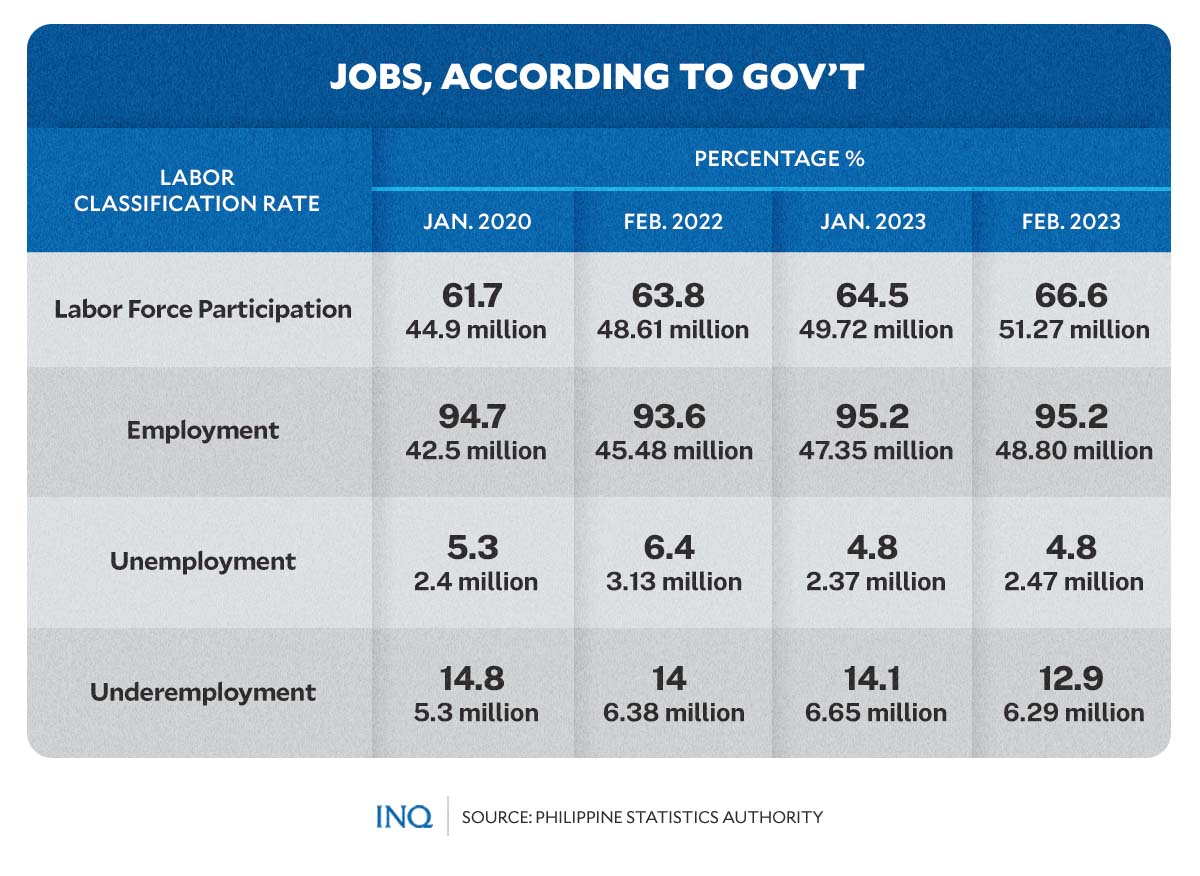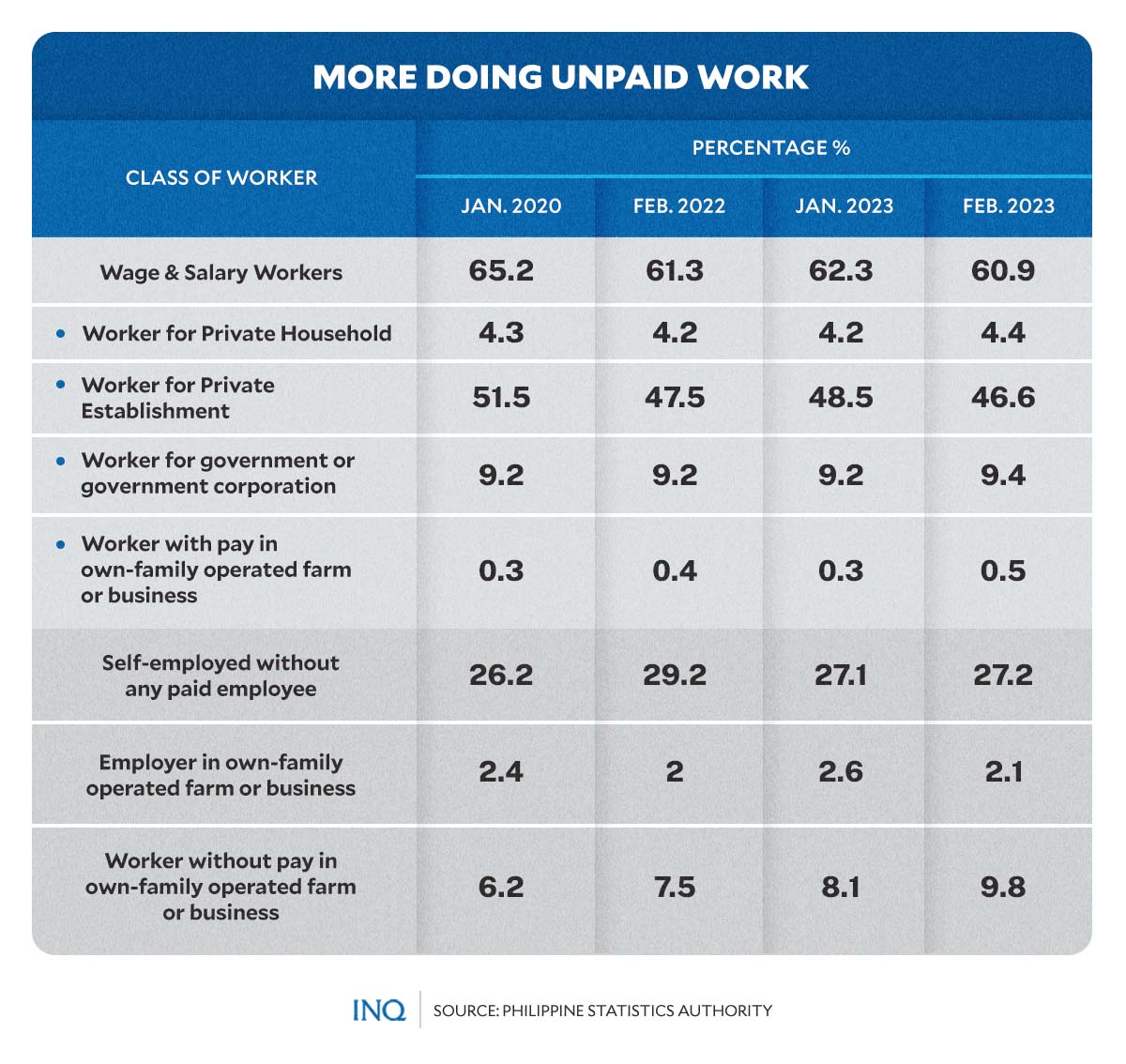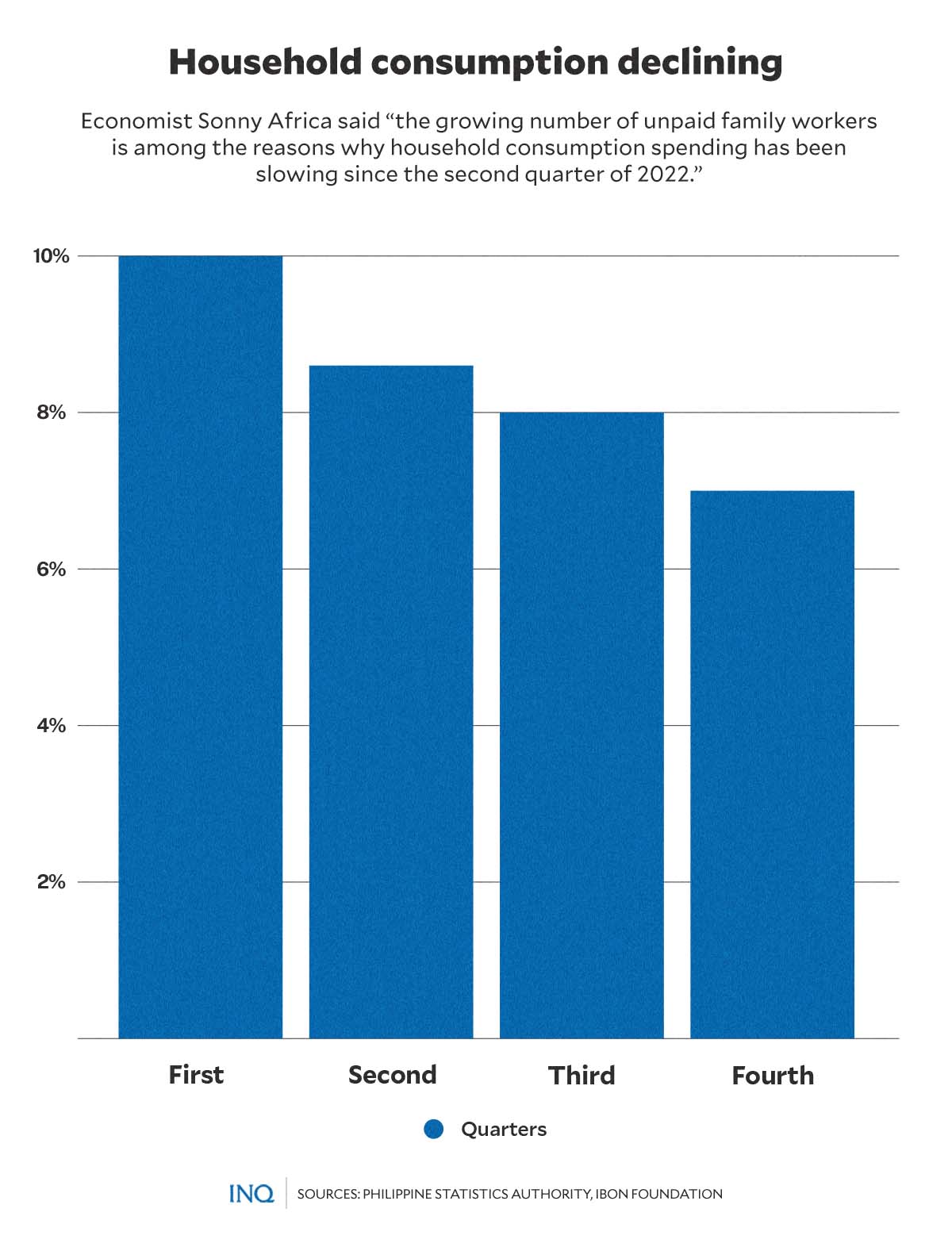Unpaid family work tears into employment numbers, bares full jobs picture
MANILA, Philippines—With the Philippine Statistics Authority (PSA) saying that more Filipinos were employed in February 2023, the National Economic Development Authority (Neda) said “employment statistics continue to improve.”
Based on PSA data, while the employment rate stayed at 95.2 percent as of January 2023, the number of employed persons increased to 48.80 million from 47.35 million in January 2023 and 45.48 million in February 2022.
READ: Jobless rate in PH remained at 4.8% in February 2023
Compared to the previous year, joblessness rate fell to 4.8 percent from 6.4 percent, while underemployment rate, or the percentage of employed persons expressing desire to have more hours of work, also declined to 12.9 percent from 14 percent.
The PSA placed the Labor Force Participation Rate at 66.6 percent, or 51.27 million in February 2023, higher than 49.7 million in January 2023, and 48.61 million in February 2022.
Article continues after this advertisementAs Socioeconomic Planning Secretary Arsenio Balisacan said on Tuesday (April 11), “the most recent data on the country’s workforce suggests that the labor market is steadily recovering.”
Article continues after this advertisementHe stressed that “the lifting of various restrictions that previously impeded employment opportunities has resulted in an increase in job prospects for Filipino workers,” stating that more Filipinos took part in the labor force, either as employed or job seekers.
RELATED STORY: Jobless rate rose to 4.8% in January 2023
However, this is not the entirety of the employment picture, which the Neda said is an indication that the labor market “continues solid performance.” As economist Sonny Africa said, “it’s always good to unpack statistics.”
Africa, executive director of the think tank Ibon Foundation, told INQUIRER.net that “the economy isn’t creating enough formal high-quality work because its agricultural and industrial foundations are so weak.”
This, as based on PSA data, the percentage of unpaid family workers, who are considered employed by the government, increased to 9.8 percent in February 2023 from 8.1 percent in January 2023 and 7.5 percent a year ago.
“The number of unpaid family workers has risen to an all-time high of 4.8 million, or a record 9.8 percent of total employment in [February 2023]. Unpaid family work was 6.2 percent of employment in January 2020, the eve of the pandemic.”
“Growing numbers of reported unpaid family workers shows that more and more Filipinos are trying to be productive and earn but unfortunately aren’t able to find any work with decent pay,” he said.
According to Africa, by class of worker, unpaid family workers accounted for the biggest share of “jobs” created since January 2023, since February 2022, and since January 2020.
“That is, more than the number of new jobs created in private establishments, government, or even self-employment,” he said.
Sinking deeper in poverty pit
Associate Prof. Karl Robert Jandoc, department chair of the University of the Philippines-Diliman’s School of Economics, explained that “unpaid family work is usually the employment of last resort.”
An unpaid family worker is someone who works without pay in family-operated farm or business by another member living in the same household.
The PSA said “the room and board and any cash allowance given as incentives are not counted as compensation for these family workers.”
Jandoc told INQUIRER.net that “the problem with unpaid family work—as the name suggests—is that it usually increases the probability of falling into poverty.”
According to him, historically, about 25 to 30 percent of unpaid workers fall below the poverty line, compared to about 11 to 12 percent for those who work for private establishments and 6 percent for those who work for the government.
Sought for comment, workers’ coalition Partido Manggagawa (PM) said being an unpaid family worker is a sad reality: “Trying to shore up family income without getting any compensation. And they are mostly women in an informal economy.”
RELATED STORY: ‘Disconnected from reality’: Gov’t told to present more honest labor numbers
“Of course, the consequence is bad for the individual’s development and well-being [since] in many cases, [unpaid family work] only means free food and accommodation for relatives asked to help in small businesses. He or she is lucky if given educational assistance, too,” the group said.
PM told INQUIRER.net that because family workers are not paid, “their needs for sustaining life are at the mercy of the ‘boss’ in the family [and] most unfortunate is that they belong to the category of ‘employed’ in our statistics.”
“Their condition needs a lift up, a transition from informal and unpaid arrangements to a more formal and paid category.”
Scarring the economy
Jandoc said “the increase of unpaid workers has many implications, including possible decrease in investments in human capital (education and health) for the family, or even potential ‘scarring’ due to loss of job experience, which can hamper labor market prospects of the worker.”
As Africa pointed out, the 4.8 million unpaid family workers in February 2023 is already higher than the 4.6 million Filipinos working in government or government corporations over the same period.
Likewise, Jandoc said while the percentage of unpaid family workers increased to 9.8 percent from 7.5 percent, or 3.2 million, a year ago, the percentage of wage and salary workers fell to 60.9 percent, or 29.72 million, from 61.3 percent, or 26.05 million.
According to Africa, “the growing number of unpaid family workers is among the reasons why household consumption spending has been slowing since the second quarter of 2022 despite what the government claims is the ‘solid performance’ of a ‘steadily recovering’ labor market.”
Based on PSA data, last year’s Household Final Consumption Expenditure slowed from 10 percent in the first quarter to 8.6 percent in the second quarter, 8 percent in the third quarter and 7 percent in the last quarter.
RELATED STORY: Dark side of PH jobs numbers: More Filipinos in outright informal work
“This is likely to be even slower in the first quarter of 2023,” Africa said, pointing out that “most unpaid work is in agriculture and retail trade which are informal economic activities with low barriers to entry but also very low and erratic earnings.”
As Africa stressed, “employment is reported as increasing but household incomes aren’t growing and aren’t even keeping up with inflation, especially among poor and low-income sectors.”
“The overall productivity of households with unpaid family workers basically just helping will likely won’t be increasing, which means that family incomes likely won’t be growing either,” he said.
He explained that with accelerating inflation since last year and persistently high prices today, this means that families will be consuming less with corresponding declines in their wellbeing and quality of life.
“Households facing medical emergencies will be worse off with the poorest families maybe just suffering ill-health, or driven deeper into poverty by medical expenses, or both,” Africa said.
Outlook
Neda said “despite the improved performance of the labor market, challenges to improving the quality of employment across sectors still remain.”
With this, Balisacan said “the government should persist in enabling the creation of high-quality jobs on the demand side and ensuring the upskilling and retooling of workers on the supply side.”
READ: Neda says gov’t committed to create more jobs amid easing jobless rate
Jandoc explained that the economy and the labor market are beginning to recover from the COVID-19 crisis, when jobs shifted away from high-productivity manufacturing and services and into agriculture and other low-productivity jobs.
But it remains to be seen whether the labor market can fully recover in the next few months–that is, if economic activity picks up and the new jobs it creates will absorb unpaid workers and some of those employed in the informal sector.
The problem, however, is that “our labor market for the past decade (and there is no indication it will be changing soon) is characterized by informal and low-productivity jobs.”
“The upshot for the government is that there will be pressure to provide some form of social protection to these workers,” he said, but “with the government finances reeling from COVID-19, this will be a tall task as it will be harder to provide timely and substantial financial and non-financial assistance.”
READ: As job count includes short-term work, gov’t urged to continue ‘ayuda’
He stressed that the challenge then, in order to achieve a “solid performance” in the labor market, is to increase productivity.
“There can be several ways to do this–foster competition, improve worker welfare, like through health/job loss insurance, invest in education and training, hasten digitalization, invest in ‘public goods’ such as infrastructure and market information, among others,” he said.
RELATED STORY: Unemployment easing? SWS survey says 1 in 3 Filipinos jobless



